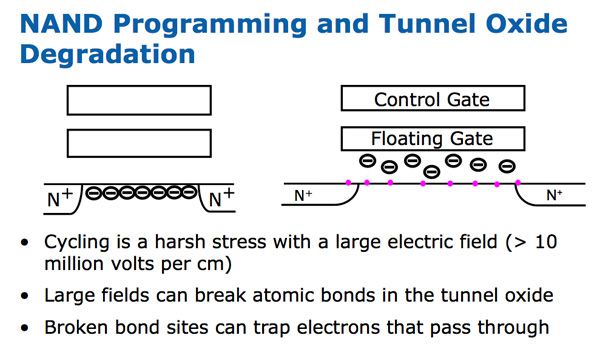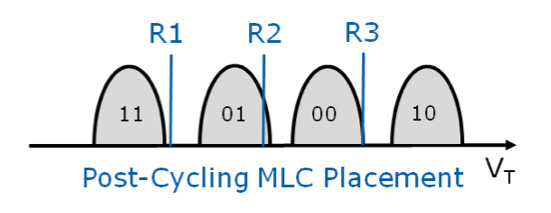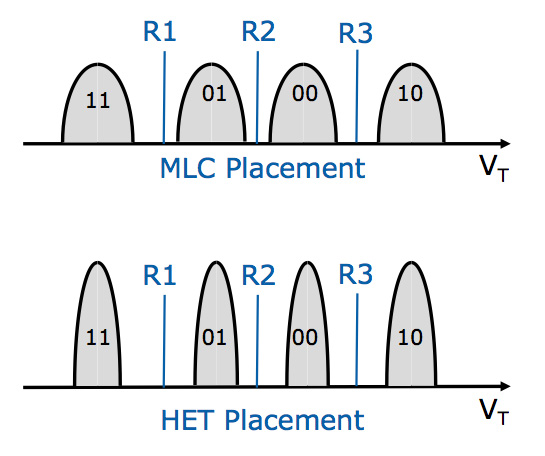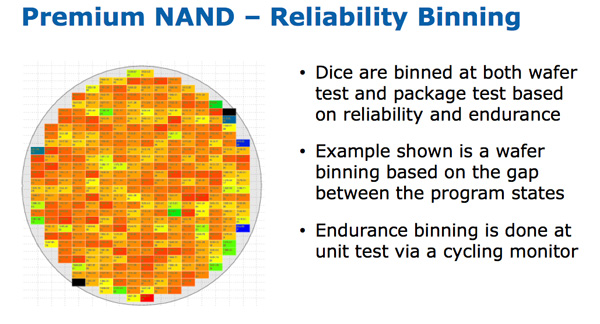The Intel SSD 710 (200GB) Review
by Anand Lal Shimpi on September 30, 2011 8:53 PM EST- Posted in
- Storage
- SSDs
- Intel
- Intel SSD 710
NAND Recap
Flash memory is non-volatile storage and in that sense it's similar to a hard drive. Once you write to a NAND flash cell it can store that data for an extended period of time without power.
You write to NAND through a quantum tunneling process. Apply a high enough voltage across a floating-gate transistor and some electrons will actually tunnel through an insulating oxide layer and remain on the floating gate, even when the voltage is removed. Repeated tunneling can weaken the bonds of the oxide, eventually allowing electrons to freely leave the floating gate. It's this weakening that's responsible for a lot of NAND endurance issues, although there are other elements at play.

NAND is programmed and read by seeing how each cell responds to various voltages. This chart shows the difference between MLC (multi-level-cell) and SLC (single-level-cell) NAND:

Both types of NAND are identical architecturally, it's just a question of how many voltages you map to bits on the cell. MLC (2-bit-per-cell ) has four different voltage levels that correspond to values while SLC only has two. Note that each value can correspond to a distribution of voltages. As long as the threshold voltage falls within that range, the corresponding value is programmed or read.
The white space in between each voltage distribution is the margin you have to work with. Those blue lines above are read points. As long as the voltage distributions don't cross the read points, data is accessed correctly. The bigger the margin between these points, the more write cycles you'll get out of your NAND. The smaller the margin, the easier it is to produce the NAND. It's easier to manufacture NAND that doesn't require such precise voltages to store and read data from each cell. Over time physical effects can cause these voltage distributions to shift, which ultimately leads to cell failure.
As MLC NAND gets close to the end of its life, these margins start narrowing considerably. Continuously programming and erasing NAND cells weakens the oxide, eventually allowing electrons to become stuck in the oxide itself. This phenomenon alters the threshold voltage of the transistor, which in turn shifts bit placements:

There's now ambiguity between bits which, if this cell were allowed to remain active in an SSD, would mean that when you go to read a file on your drive there's a chance that you won't actually get the data you're requesting. A good SSD should mark these bits bad at this point.
There's a JEDEC spec that defines what should happen to the NAND once its cells get to this point. For consumer applications, the NAND should remain in a read-only state that can guarantee data availability for 12 months at 30C with the drive powered off. Manufacturers must take this into account when they test and qualify their NAND. If you're curious, JEDEC also offers guidelines on how to cycle test the NAND to verify that it's compliant.
By now we all know the numbers. At 50nm Intel's MLC NAND was rated for 10,000 program/erase cycles per cell. That number dropped to 5,000 at 34nm and remained at the same level with the move to 25nm. Across the industry 3,000 - 5,000 p/e cycles for 2x-nm 2-bit-per-cell MLC (2bpc) NAND is pretty common.
For desktop workloads, even the lower end of that range is totally fine. The SSD in your desktop or notebook is more likely to die because of some silly firmware bug or manufacturing issue than you wearing out the NAND. For servers with tons of random writes, even 5K p/e cycles isn't enough. To meet the needs of these applications, Intel outfitted the 710 with MLC-HET (High Endurance Technology) more commonly known as eMLC.
Fundamentally, Intel's MLC-HET is just binned MLC NAND. SLC NAND gets away with having ultra high p/e cycle counts by only having two bit levels to worry about. The voltage distributions for those two levels can be very far apart and remain well defined over time as a result. I suspect only the highest quality NAND was used as SLC to begin with, also contributing to its excellent endurance.
Intel takes a similar approach with MLC-HET. Placements are much more strict in MLC-HET. Remember what I said earlier, narrow ranges of voltages mapping to each bit level reduces the number of NAND die that will qualify, but you build in more margin as you cycle the NAND. If placements do shift however, Intel's SSD 710 can actually shift read points as long as the placements aren't overlapping.

Similar to frequency binning CPUs, the highest quality NAND with the tightest margins gets binned into MLC-HET while everything else is shipped as standard MLC. And just like with frequency binning, there's a good chance you'll get standard MLC that will last a lot longer than it's supposed to. In fact, I've often heard from manufacturers that hitting up to 30K p/e cycles on standard MLC NAND isn't unrealistic. With its MLC-HET Intel also more frequently/thoroughly refreshes idle NAND cells to ensure data integrity over periods of extended use.

Intel performs one other optimization on MLC-HET. After you've exceeded all available p/e cycles on standard MLC, JEDEC requires that the NAND retain your data in a power-off state for a minimum of 12 months. For MLC-HET, the minimum is reduced to 3 months. In the consumer space you need that time to presumably transfer your data over. In the enterprise world, a dying drive is useless and the data is likely mirrored elsewhere. Apparently this tradeoff also helps Intel guarantee more cycles during the drive's useful life.

At IDF Intel told us the MLC-HET in the SSD 710 would be good for around 30x the write cycles of standard (presumably 25nm) MLC. If we use 3,000 as a base for MLC, that works out to be 90K p/e cycles for Intel's 25nm MLC-HET.










68 Comments
View All Comments
inplainview - Saturday, October 1, 2011 - link
Useless toys? Is this coming from someone that can't afford Apple's offerings or someone who hasn't figured out that Apple is in the mainstream of consumer offerings and mentioning them is this consumer space is quite appropriate considering Apple's influence. You have proven yourself to be myopic and petty.Stas - Sunday, October 2, 2011 - link
umadbro? Everything Apple sucks :Dgevorg - Saturday, October 1, 2011 - link
At least there is no Top 100 iPhone apps here. :)web2dot0 - Friday, September 30, 2011 - link
Unfortunately, that's what people want to read nowdays. Anand is just targeting the mainstream. Otherwise, how will he get all the pageviews? It's a business afterall. Let's not be naive. He doesn't choose his articles to write about by random. There's always a reason to the madness. He's just trying to stay (slightly) ahead of the curve. Too hard out, and it'll become irrelevant.Just wish the team stops writing so many editorial news reporting and focuses more on technical analysis like the ones above. The site is slowly becoming more and more corporate and with time, it will lose it's edge.
Anyways, it's not like other sites are that much better. There's always room for improvement ....
taltamir - Saturday, October 1, 2011 - link
Apple has single digit market-share. This is as far from mainstream as possible.B3an - Saturday, October 1, 2011 - link
....Yeah in computers but thats it. Apple are the largest consumer tech company on the planet, they now make more money than Microsoft. Apple pretty much have a monopoly on MP3 players and online music. They have the single best selling phone, the best selling tablet, and are gaining PC market share. For tech stuff you cant get more mainstream than Apple. There useless devices dont belong on serious sites like this IMO, they belong on dumbed down crap like Engadget.inplainview - Saturday, October 1, 2011 - link
How many of you would be willing to financially support this site so that you can get your truckload of geek? Most likely zero to none. This site is supported via page hits which means that the authors have to write about stuff that most of the basement dwellers here aren't interested in. However, as someone who actually goes out into the sun, knows what women look like, smell like, taste like (figure it out), and realize that there is a world outside of sitting in front of a keyboard and bitching about how this site is not this and that, I can appreciate the work put in. Some of you people are simply whiners and pathetic.Stas - Sunday, October 2, 2011 - link
Apple unofficially owns EngadgetKPOM - Saturday, October 1, 2011 - link
In the US, Apple has the third largest share of the PC market.http://arstechnica.com/apple/news/2011/07/apple-no...
It's lower worldwide, but Apple is definitely a mainstream PC manufacturer.
http://osxdaily.com/2011/03/18/mac-market-share-ar...
Penti - Saturday, October 1, 2011 - link
Anandtech is far from and far more then just a gadget site. Times change and you have to keep up with that to. So of course the focus changes, it's not all about the baddest mainstream overclocking mainboards and high-end gamer gpus any more, things have changed and people come here because it's not just fluff but also digs through down in the hardware/product. You will have more smartphones, notebooks and so on the gpu wars itself won't get you a lot of readers. You will have more enterprise topics and so on. Computing has changed. It's not really about gaming any more and that market has changed.